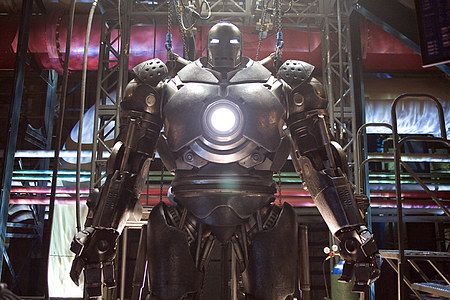 |
 |
4More Pages
|
||||||||||
 |
 Initial Design Concept Process Initial Design Concept ProcessProducer Feige was impressed with the actor's ability up on the wire rigging. “Downey is a pro across the board,” says Feige. “He is an amazing actor and he really put in the time required to master the technique. It's a great scene because, early on, Tony Stark moves in a way that shows he needs to test his boots and gauntlets abilities, which was very funny. But then, as he begins to master the technology, he starts to move around and fly in a completely heroic manner - which is the birth of Iron Man.”
Tony Stark continues to refine the suits' technology, which eventually results in the high-tech, sleek, sophisticated, red and gold Mark III armor. The Mark III armor that has become synonymous with the Iron Man character was created, designed and built in partnership with Stan Winston Studios, Phil Saunders and Adi Granov.
“The Mark III suit is a character in the movie,” says Favreau. “Tony Stark takes on a different character when he's wearing the suit and he's able to do things he would never otherwise dream of doing. The suit gives him the personality of a hero and I really wanted the Mark III Armor to look like it just stepped out of the comic book and onto the big screen.”
Illustrator Phil Saunders recalls the initial design concept process for Iron Man's Mark III armor: “Jon sent me a sketch he had commissioned Adi Granov to execute, which was an interpretation of the suit from 'The Extremist' series of the comic book,” says Saunders. “Adi's design was pretty amazing, but they'd been living with that design for quite some time and wanted the suit to have a little bit more of a stealth design. Whatever innovations I would come up with were sent to Adi, who would do an aesthetic pass on everything because he has a particular way of smoothing everything out and getting all the lines to flow with this beautiful proportion that everyone in the comic book world really admired.
Saunders continues, “Once we got a design that was pretty solid, I did elevations of traditional three-view - top, side, front and back - illustrations of the suit that we then sent to Eddie Yang at Stan Winston Studios. He took those designs and used them as templates to build a 3-D model. Then both Adi and I worked with Eddie in refining every single surface to make sure that the proportions and the detailing matched the filmmakers' vision of the suit."
“Phil Saunders and Adi Granov did a fantastic job of finding the right proportions for the Mark III suit,” says executive producer D' Esposito. “In the comic book industry there's what is called 'heroic' proportions - anywhere from eight to ten heads tall for a human figure. This looks fantastic in a comic book, but freakishly alien if translated literally into the film world. Jon was very concerned that the look of the suit be utterly convincing. When Tony Stark puts on this suit, he doesn't just become a man in a powered suit, he becomes an iconic character, so it was very important for the suit itself to have a heroic level of personality as well as make us believe there's actually a human being inside of it.”
With the design concept of the Mark III in place, Stan Winston Studios' Shane Mahan began the process of building the suit. “'Iron Man' was interesting because there was already a series of design ideas in place, so our job was to bring them into our world and render them functional,” says Mahan. “The big challenge when we first started was the fact that they hadn't cast anyone to play Tony Stark. They had conceptual drawings of Iron Man that fit a certain body type. So we spent many weeks building and sculpting a 3-D model in the computer. We were also able to take those computer models and rig them internally so we could do motion studies even before we had physical parts. This allowed us to see what parts of the suit were going to be troublesome so we could make adjustments accordingly.”
Conceptual designer Saunders was impressed with Stan Winston Studios' technique in developing the physical parts of the suit. “The real thrill in working on projects like this is seeing it come to life,” says Saunders. “The process that Stan Winston Studios took from 3-D modeling worked extremely well. They used a system called 'polygonal modeling' where you start with a very faceted surface that procedurally becomes smooth to a much more accurate surface. They were able to create some absolutely fantastic surfaces, so when they started milling the parts, every single surface was absolutely perfect.”
Mahan summarizes the steps and materials involved in creating the Mark III suit: “The design process in a nutshell is conceptual art which is turned into a computer model that's mathematically precise to the scale, then a full-scale one-to-one replica was rapid prototype grown, then those parts were perfected, body-shopped and molded, and castings are made and set into the construction of the suit.”
Mahan continues, “In the process of creating the suits we used a multitude of materials that included lightweight epoxies and urethanes and a great deal of actual chrome surfacing with substructures that are metal because you have to make these suits strong enough to withstand four months of filming, but light enough for a person to move around in.”
|
|||||||||